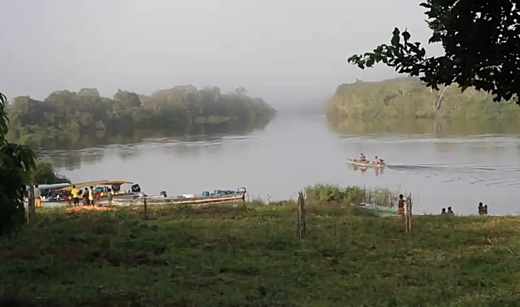 Image above: Saudi irrigated agriculture is being abandoned as too water insensive. From (http://www.eosnap.com/image-of-the-day/agriculture-in-saudi-arabia-november-7th-2008).
Image above: Saudi irrigated agriculture is being abandoned as too water insensive. From (http://www.eosnap.com/image-of-the-day/agriculture-in-saudi-arabia-november-7th-2008).
At some point in our lives, most of us realized that there is no place that we could stand on the side of Mother Earth and not be asked, “by what right are you here?” Do we have a rent receipt, a park pass, a ticket, a passport? Even the rare humans in the Amazonian interior cannot get out of Brazil without a passport.
And when I do have a rent receipt, who is it that “benevolently” and tentatively extend those rights to me? An armed gang of thugs who call themselves “civilization” own Mother Earth. This loosely organized gang of thugs are composed, usually, into a male hierarchy, generally referred to as the planetary, military patriarchy. This gender imbalanced, group of fat bankers in business suits, with generals at their side, owns the Earth. These are the descendants of the original patriarchs who began the warfare – looting -death oriented, empire culture, who apparently believed that because males are larger and stronger, they should kill the opposition and loot the earth of material goods, which they call “wealth” and conflate with “power.”
Now, they have done it. They have looted the Earth almost to its death. Babylon ecologically destroyed Iraq, the Indus Empire ecologically destroyed the Indus Valley, the Han Chinese ecologically destroyed China and the Greek and Roman empires ecologically destroyed North Africa and Italy and now the patriarchs are sucking the life force out of the whole Earth. The patriarchs are not standing on the living Earth, they exist in a mentally conditioned bubble that tells them that the more the Earth dies, the better things get. They call it the sacred growth. They babble incessantly about economics, politics, and fast cars. At the universities they have answers to all questions, but the reality here on the Earth is simple.
The Giant Vacuum Cleaner They Call Economics
They have set up a giant vacuum machine that can identify any valuable biological activity on the Earth. Down here on the Earth, the soil community of millions of members slowly builds up surpluses. In optimum ecologies, this community can produce one inch of topsoil in three hundred to nine hundred years. The giant machine identifies the biologically rich areas of soils, fish stocks, forests, grasslands and so forth in which to plug its tentacles. The sucking sound is the life force leaving our planet. Of course, they babble on about their theories of economics and politics as they try to justify their methods of sharing the loot, which they have sucked out of the planet’s life force. In this culturally conditioned reality bubble, we have more regard for the house made of dead trees than we have for the living forest itself.
The industrialists prattle on about value. What is it that makes our loot valuable? The industrial Marxist, in his bubble, says that it is human labor that makes things valuable, the voice from the industrial capitalist bubble says it is whatever people will pay.
Back on the Earth, the life force maintains a web of energy flows. The sunlight is consumed, photosynthesis increases biomass, the leaf falls from the tree, it becomes food for the soil community, which creates fertility for the tree. This exemplifies the vastly more manifold and complex web of life of the Earth. No life form attempts to take over the whole. Each lives according to its nature in dynamic balance with the web of life.
Therefore, each life form that exists in dynamic balance within the web of life has a right to be here on Earth because it’s part of the function. In addition, because the local conditions in the cosmos have created the environment for life to exist on Earth, we can say that the life form has even cosmic rights. Therefore, if you are existing in dynamic balance with the web of life of the planet Earth, YOU HAVE A RIGHT TO BE HERE ON THIS PLANET EARTH, otherwise you and I are biologically illegitimate criminals intent on murdering our mother.
When we examine, say, our own liver, we see a cell community happily cooperating with the body’s design in doing liver things. In some extreme case we might see a small group of cells cancerously declare that they don’t like the cosmic design and they commit to creating a (tumor) body of their own design. They then begin sucking the life force out of the larger body and growing their own tumor body until the larger body dies.
We are now at the crime scene. There are individual life forms loose on the planet that are cancerously sucking the life out of larger benign bodies. We call ourselves, “the civilized.” And how did this criminal enterprise begin?
For several million years our species lived very successfully on the Earth, embedded in the ecological energy flows as forager/hunters. With our encyclopedic knowledge of the living Earth, we knew plants come from seeds and also where the seeds should be planted. Many forager/hunters planted seeds along the foraging routes, to return later. But, at some point, some humans decided that they didn’t like the design of the larger body and began the practice of agriculture as a way of life. This was the fateful decision that has almost sealed the fate of our planet.
What happened on the ground? Those humans stopped the foraging migrations and became embedded in one spot. They began to suck biological surpluses from the soil with farming and grazing. They accumulated food and material objects in their buildings. Because they had “wealth” to protect, a male, military hierarchy was created. They were protecting material goods and thus materialism came into the new culture. The idea of linear increase, growth, progress became imbedded in the culture as the patriarchs began to envision “bigger barns and broader acres.”(1)
Steven Mithen, in his book, After the Ice, describes a neolithic village called Ain Ghazal, in the Mid-East. The archeologists, going down the layers find animal bones and pollen counts that indicate an original luxury of animals and plants, including farm produce. As time went on, the two thousand person town was reduced to zero as the wild game disappeared, the soils were exhausted and eroded and the trees cut down.(2) In some “civilized” cultures the people didn’t disappear, but the problem metastasized. If one sucks the biological energy out of their area, they have to spread out and conquer new soils, forests and grasslands and get on the path toward empire.
From this mix we get “civilization,” a brutish mass of mutant, hyper-male killers who’s culture makes famous mass, serial killers such as Alexander the Great, Caligula, George Bush and Ted Bundy.
Our species made a terminal mistake. We did not observe the first principle of living on the Earth – ECOLOGICAL BALANCE, and the second, LIFE HAS VALUE.
We Are Now Ready To Overthrow The Pathological Patriarch
Millions of us are now ready. They call us “alternatives,” “cultural creatives,” “hippies,” “radicals,” un-Russian, un-British and un-American. Out of the intuition of the masses has come the new culture. The new culture emphasizes gender balance and consensus government. The new culture of non- industrial medical care points to herbal medicine, energy medicine, Reiki, nutrition, naturopathic, yoga, homeopathic, yoga, and much more.
Many have thought we are trying to wear loin cloths and eat roots and berries. Although our forager/hunter ancestors were successful, there have been many human cultures that have existed in ecological balance. It is ecological balance, not loin cloths that we are discussing. The Nabateans of the Negev Desert in the Mid-East, from 200 b.c. to 100 a.d. created a superlative civilization out of a barren desert with human creativity. Anthropologist D.A. Posey describes the Kayapo´ of the Amazon who grow well over 100 different species in their rainforest gardens (which to the uninitiated look like more rainforest) of an acre or less.(3) The Inca Civilization existed without ecological destruction.
We now have Permaculture as a balanced way of getting our nutrition from the Earth. Permaculture is a wholistic body of strategies that seeks to mimic ecological processes and can grow more food per acre than the industrial system while building the soil and providing homes for other creatures.
We now have a huge alternative building movement of straw bale, cob, rammed earth, earth bag, adobe, and much more that rely on local materials. We now have alternative solar homes that can heat and cool themselves without outside energy.
We have the Global Ecovillage Network (4) which has thousands of ecovillage members around the planet all pointed toward self-sufficiency and balance with the life force.
We have “alternative” people who are expanding the human potential by perceiving and communicating with the life force of the planet.(5)
We even have new wave economists who lay out a plan for a new cooperative economy. (6)
People living with nature, on the land, in ecovillages with an artisan economy are the picture of social stability and self-sufficiency. With this means we can establish a culture that can prevent hierarchy and can prevent the creation of surpluses that would support militaries, dictators, emperors, shopping mall addicts and centralized governments.
We are now living out the last gasps of materialistic, industrial civilization and the dying away of the flesh of our planet, with its exploding population and dwindling resources. If there were any maturity in the human societies they would be glad to sponsor experimental communities such as ecovillages. Wouldn’t it be wonderful if the death culture could push through a few surviving ecologically balanced human communities past the apocalypse to become the seeds of the new human culture based on the principles of life?
(1) Chapter 9, The Cultural Dynamics of Empire. The Final Empire: The Collapse of Civilization and the Seed of the Future. Wm. H. Kötke.
(2) After the Ice: A Global Human History, 20,000-5,000 B C. P. 87.
(3)Indigenous Peoples and Tropical Rainforests: Models of Land Use. Cultural Survival Report #27. Jason W. Clay. 1988.
(4)http://www.gen.ecovillage.org
(5)Plant Spirit Healing: A Guide to Working With Plant Consciousness. Pam Montgomery. Bear & Co. 2008.
The Secret Teachings of Plants: The Direct Perception of Nature. Stephen Harrod Buhner. Bear & Co. 2004.
(6)http://www.ied.info/blog/1414/an-understandable-full-and-equal-rights-economy-in-170-words











